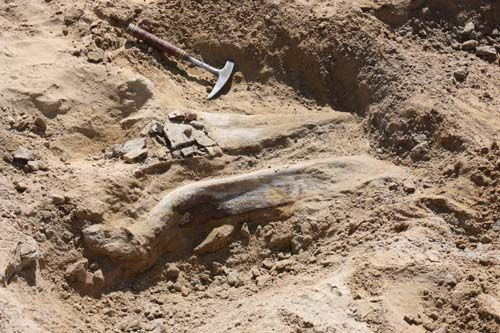Rare Triceratops Fossil Found At Colorado Construction Site Includes Skull

Paleontologists have confirmed that the dinosaur fossil construction workers stumbled upon near Denver is a rare triceratops skeleton.
The City of Thornton said on its website that the workers unearthed the fossil at the site of the city’s new public safety building, a fire and police substation, and called in scientists from the Denver Museum of Nature & Science.
“My heart was racing,” museum dinosaur curator Joe Sertich said in the city’s post. “I realized it was a pretty important dinosaur find.”
The triceratops skeleton includes a skull. The curator explained on Facebook that after getting a call about the potential fossil find, which described it as possibly being a leg bone and a pelvis, he went down to the construction site, in the northern Denver metro area, and helped clean off the bones. “We realized it was the horn of a triceratops and probably a shoulder blade of a triceratops right next to it,” he said.
More was slowly unearthed from there, with the city describing a jaw and an eye socket.
The pics show some of the initial wk. The fossil shown below shows the bottom jaw, top jaw and eye socket. #Thornton #dinosaurs #triceratops pic.twitter.com/8y2CXPfrZJ
Sertich said that the triceratops is a rare find for the area.
“This is probably one of only three skulls of triceratops found along the Front Range area,” Sertich noted in the city’s post, referring to an eastern section of the Rocky Mountains that runs through Wyoming and Colorado.
Usually scientists find fossils that are between 10,000 and 12,000 years old — dating back to the last ice age — but the triceratops skeleton, which has not yet been dated, has been lying in wait at least since the dinosaurs went extinct.
“This dinosaur has been laying here for at least 66 million years,” says Sertich. “I’m over the moon right now about this dinosaur fossil.”
Thornton officials confirmed that after their equipment was “stopped by an immovable object” and they called in the experts, the construction crew has stopped work in the fossil’s area while scientists slowly dig it up and search for other bones. There could be remains from the rest of the triceratops skeleton, which would spread across a relatively large area.
These bones might eventually find a home at the museum.
The fossil is not visible from the street, the city noted.
“I’ve been at the museum now for six years and we have not hit one of these dinosaurs yet, and so to finally hit one of these dinosaurs on a construction site is basically what I’ve been waiting for the last six years,” Sertich said in a video posted on the museum’s Twitter account.
The triceratops might be one of the better known dinosaurs because of its distinct look. This four-legged herbivore had two big horns above its eyes and one on its nose — hence its name that means “three-horned face” — as well as a protective frill at the back of its head made out of bone. It weighed several thousand pounds and was one of the last walking dinosaurs to evolve before the mass extinction that killed them off about 66 million years ago.
“A lot of times these will be plowed up and they won’t be recognized,” Sertich said, referring to fossil finds. “We’re really lucky in this case that it was recognized as fossils and we got the call.”
See posts, photos and more on Facebook.
© Copyright IBTimes 2024. All rights reserved.




















